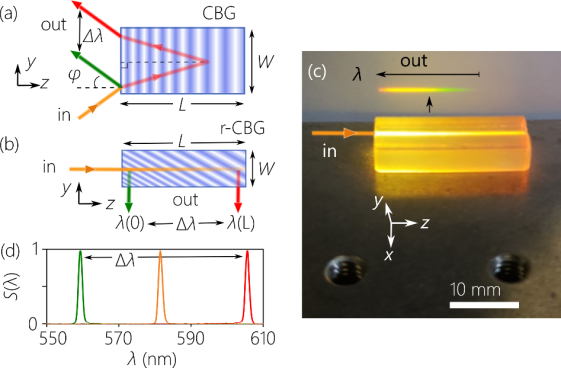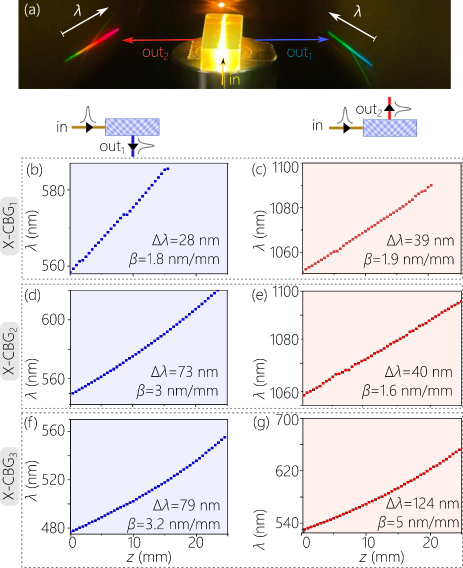A new optical component — a rotated chirped volume Bragg grating (r-CBG) — that spatially resolves the spectrum of a normally incident light beam in a compact footprint and without the need for subsequent free-space propagation or collimation was developed by our group recently. Unlike conventional chirped Bragg volume gratings in which both the length and width of the device must be increased to increase the bandwidth, by rotating the Bragg structure we sever the link between the length and width of an r-CBG, leading to a significantly reduced device footprint for the same bandwidth.

Fig. 1. (a) Spatially resolving the spectrum of a beam obliquely incident on a regular chirped Bragg grating. (b) r-CBG configuration for spatially resolving the spectrum of a beam normally incident on medium, (c) a physical realization and (d) Measured output spectrum in (c) at z = 0, L/2, L.
A further advance in the functionality of r-CBGs is achieved by realizing a dual-band spectral analysis device in which two r-CBGs are multiplexed in the same volume. One r-CBG is written at an angle 45° with respect to the propagation axis and operates in one spectral range, and another r-CBG operating in a distinct spectral range is written at an angle -45° (orthogonal to the first). Because the chirped Bragg structure has the form of orthogonally intersecting lines throughout the device volume, we call this new optical element an X-CBG. When two optical signals in different spectral bands are incident normally at the entrance facet, the spectrum of one signal is spatially resolved and directed normally out of one facet, while the spatially resolved spectrum of the other signal exits from a different facet. We confirm the operation of X-CBG’s in visible and NIR spectral channels, and in contiguous spectral ranges in the visible (Fig. 2).

Fig. 2. (a) Photograph of an X-CBG capable of dual-band spectral analysis in the visible. A white-light source is directed to the X-CBG (bottom), the spatially resolved short-wavelength portion of the spectrum is directed to the right, and the long-wavelength portion to the left. (b,c) Spectral measurement of the spatially resolved spectra from the two exit facets of X-CBG1. (d,e) Same as (b-c) for X-CBG2. (d) Same as (f,g) for X-CBG3. The insets depict the measurement configurations.
CBG1. (d,e) Same as (b-c) for X-CBG2. (d) Same as (f,g) for X-CBG3. The insets depict the measurement configurations.